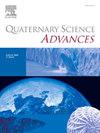Reconciling the environmental implications of late Quaternary faunal and pollen records in southern Africa
IF 2.2
Q2 GEOGRAPHY, PHYSICAL
引用次数: 0
Abstract
Across southern Africa, the Pleistocene-Holocene transition was associated with changes in community composition of large mammalian herbivores, which included the extinction and extirpation of numerous grazers. Past research has often linked these changes to the contraction and disappearance of grasslands; however, the relationship between faunal and pollen records spanning this transition has not been systematically analyzed. Here, we investigate changes in fossil ungulate community composition and grass pollen abundance from late Quaternary sites across southern Africa to evaluate the extent to which these communities track paleovegetation change across this interval. Our dataset draws from faunal and pollen records across southern Africa. Results from the comparison of compositional changes in both records suggest a sub-continental-scale decoupling of grass cover and ungulate community composition during the Pleistocene-Holocene transition. Although there is strong evidence for a regional-scale decline in grazers from the Last Glacial-Interglacial Transition to the early Holocene, there is no evidence for regional-scale declines in grassy vegetation. Several potential mechanisms may account for this decoupling of grazers and grass abundance. The possible strengthening of winter rainfall systems during glacial Pleistocene may have played a role by enhancing year-round availability of grasses in the interior and by elevating moisture availability and productivity in the Cape Floristic Region. Alternatively, current paleoecological data allow for the possibility that Pleistocene ‘grazers’ consumed more dicots, such that their decline at the onset of the Holocene reflects dietary niche contraction rather than vegetation change. These findings contribute to a growing body of evidence challenging the link between grass abundance and grazer diversity and complicate our understanding of the drivers of late Quaternary extinctions in southern Africa.
协调非洲南部晚第四纪动物和花粉记录的环境影响
在整个非洲南部,更新世-全新世的过渡与大型食草哺乳动物群落组成的变化有关,其中包括大量食草动物的灭绝和灭绝。过去的研究经常将这些变化与草原的收缩和消失联系起来;然而,跨越这一转变的动物群和花粉记录之间的关系尚未得到系统的分析。在这里,我们研究了非洲南部晚第四纪遗址的化石有蹄类群落组成和草花粉丰度的变化,以评估这些群落在这段时间内追踪古植被变化的程度。我们的数据集来自非洲南部的动物和花粉记录。两种记录的组成变化对比表明,更新世-全新世过渡时期,次大陆尺度上草被与有蹄类群落组成存在解耦。虽然有强有力的证据表明,从末次冰期-间冰期过渡到全新世早期,食草动物在区域尺度上有所减少,但没有证据表明草类植被在区域尺度上有所减少。几种潜在的机制可以解释这种食草动物和草丰度的脱钩。冰川更新世期间冬季降雨系统的可能加强可能通过提高室内牧草的全年可用性和通过提高开普植物区水分的可用性和生产力发挥了作用。另外,目前的古生态数据表明更新世的“食草动物”消耗了更多的植物,因此它们在全新世开始时的减少反映了饮食生态位的收缩,而不是植被的变化。这些发现有助于提供越来越多的证据,挑战草丰度与食草动物多样性之间的联系,并使我们对非洲南部晚第四纪物种灭绝驱动因素的理解复杂化。
本文章由计算机程序翻译,如有差异,请以英文原文为准。
求助全文
约1分钟内获得全文
求助全文
来源期刊

Quaternary Science Advances
Earth and Planetary Sciences-Earth-Surface Processes
CiteScore
4.00
自引率
13.30%
发文量
16
审稿时长
61 days
 求助内容:
求助内容: 应助结果提醒方式:
应助结果提醒方式:


